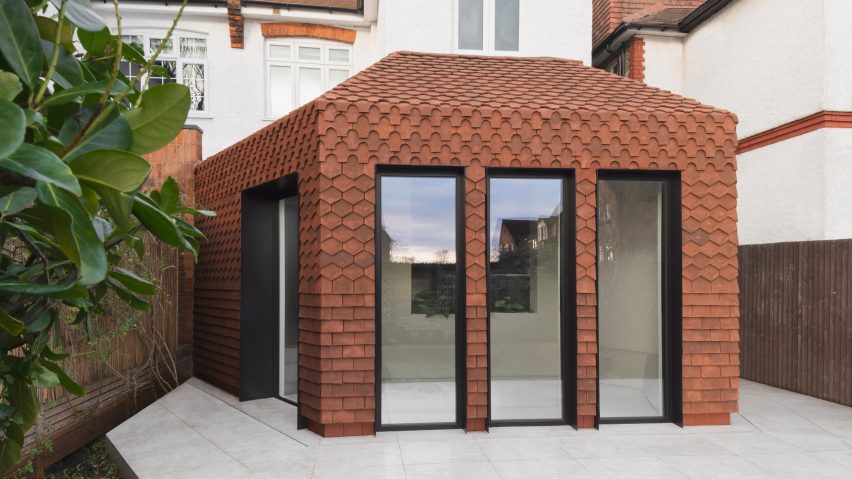A sunken living room and decorative red tiles define this residential extension, which architecture studio Bureau de Change has added to Clay House in East Finchley, London.
The rear extension is designed for a family of three and offers them a space for leisure and entertainment activities while accommodating their extended family.
Bureau de Change's design takes visual cues from the Victorian architecture of the existing semi-detached house, as well as sunken boxing rings from the same era.
According to the studio, Victorian boxing rings informed the design of a conversation pit that occupies the part of the extension between the kitchen and garden.
"In the early Victorian era, the sunken boxing ring design was employed to optimise spectator views, enabling a clearer sightline of the events unfolding inside the ring," said the studio's co-founder Billy Mavropoulos.
"This typology was also intended to establish a natural barrier between the fighters and the audience, a characteristic we harnessed to form the interior spatial divisions, complemented by a shift in materials from the kitchen to the living area," he told Dezeen.
Meanwhile, the extension is clad in red clay tiles in a range of shapes, intended to echo those on the Victorian home's original curved window, roof and porch.
"These tiles exhibit a distinctive and traditional profile, showcasing elements like club and square cuts," said Mavropoulos. "Recognising the exceptional value of this existing architectural feature, we were determined not to overlook it but rather leverage its uniqueness to craft a surprising yet contextual new addition."
Alongside the sunken lounge, Clay House comprises an open-plan kitchen and dining room that leads into a living area at the front of the home.
The extension is described by Bureau de Change as having an "unorthodox geometry", which Mavropoulos said is a response to an adjacent extension and local planning laws that required a separation of 45 degrees between neighbouring homes to minimise disruption.
"To optimise the internal space, the extension incorporates the existing party wall of the neighbour's rear extension, using its lowest height to determine the eave height," said Mavropoulos.
"As a result, it takes on a skewed, faceted shape that is directly informed by the immediate surroundings."
Clay House is complete with a pared-back material palette, with off-white walls and wooden floors and furnishings.
Large windows that puncture the extension help illuminate the space while framing views out to the rear garden.
London studio Bureau de Change was founded by architects Mavropoulos and Katerina Dionysopoulou in 2012. Its other recent projects include the interior design of a mixed-use development in an art deco building in Fitzrovia and a home in south London that uses concrete to mimic the motifs from surrounding 1930s brick housing.
Other recent extensions featured on Dezeen include an addition to a home in Stoke Newington by Whittaker Parsons that is clad in copper and larch and another in Australia by Grotto Studio that is clad in charred timber.
The photography is by Gilbert McCarragher.

